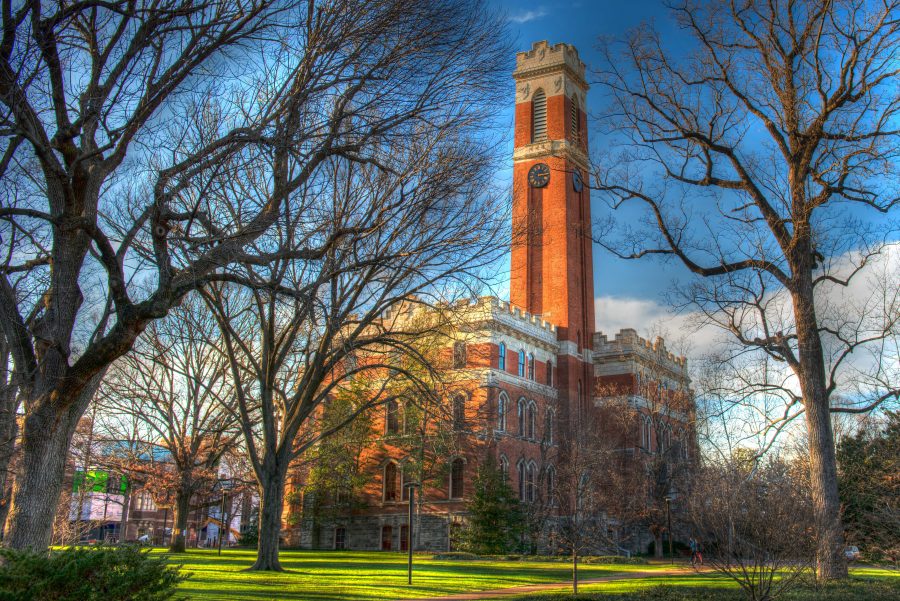For the first time in the history of the survey, the Journal of Blacks in Higher Education reports that Vanderbilt had the highest percentage of Black students in the 2017 entering class among peer high-ranking research universities. With 226 Black students in the freshman class, 14.1 percent of the class identifies as Black. The next closest university was Columbia University with 13.9 percent of first years identifying as Black.
Vanderbilt has seen a steady increase in Black first-year enrollment over the years. This year’s is up from 12.2 percent in 2016, and 10.8 percent in 2015.
[infogram id=”percentage-of-black-students-in-vanderbilt-incoming-classes-1ho16vx31xkv4nq”]
“To give that perspective, in 2001, our African American population was 5.7 percent,” Vice Provost Doug Christiansen said. “Now we’re within about a percent and a half from mirroring the population of African American students in the college bound class. That is phenomenal.”
Christiansen credits initiatives like new pipelines and recruiting strategies with increasing diversity in the applicant pool. Vanderbilt’s admissions staff works with Community Based Organizations around the country and forms partnerships with nonprofits like Posse and Questbridge to reach students in under-resourced areas.
“In 2006 when I arrived, we had about 12,900 applicants, to 32,000 this year,” Christiansen said. “And what’s important is, not just apps grew, but all the populations within that grew.”
He stressed, however, that this growth did not come with a lowering of standards. In fact, the university called the class of 2021 its “most diverse and accomplished class” ever.
“Our standards have increased on everybody. It is hard to get into Vanderbilt, and it is hard for everybody.”
One of the biggest changes that Christiansen cites is in financial aid through the introduction of Opportunity Vanderbilt. Vanderbilt pledges to meet 100% of demonstrated need without loans, and does not base aid on income tiers.
“Opportunity Vanderbilt opened the gates to people who had never had the opportunity to look at Vanderbilt. And it’s because there’s no income cap.”
Vanderbilt is not the only school committed to bringing in more talented, low-income students. The American Talent Initiative, which Vanderbilt joined last year, is a coalition of nearly 300 colleges that aims to increase the number of Pell Grant eligible students by 50,000 by 2025.
“It’s fun to be number one, but really the success is that we’re seeing everyone go up,” Christensen said. “We don’t win if just we do.”
Beyond increasing diversity in admissions, Vanderbilt is looking for ways to increase feelings of inclusion on campus. Vice Provost Melissa Thomas-Hunt says that the Visions program has brought the notion of Inclusive Excellence front and center.
“You have an entire class of our entering students, who in relatively small communities are learning with individuals both similar and different from one another, and are tackling some of the most challenging questions,” Thomas-Hunt said.
In addition, university-sponsored inclusive programming has been made a priority under the Office of Social Justice and Identity headed by Associate Dean of Students Dr. Frank Dobson. The six offices included under this new initiative are LGBTQI Life, the Office of the University Chaplain and Religious Life, Inclusion Initiatives and Cultural Competence, the Black Cultural Center, the Women’s Center, and Transition Programs.
Thomas-Hunt understands that even with the focus on programming, there is a struggle to make new progress and resources visible. This is especially true when much of the university’s effort has been put toward inspiring an inclusive campus culture through meaningful conversations, as opposed to tangible programming.
“When you’re here, it’s largely a cross section and it feels very static,” Thomas-Hunt said. “But if you have the benefit of a historical perspective, you begin to see the huge progress that’s being made.”
Beyond programming, Christiansen said that tangible commitments to inclusion like Opportunity Vanderbilt, which makes the university more accessible to a wider range of students, are a way to show potential students and those already on campus that the school wants to increase its diversity.
“Opportunity Vanderbilt is one of the biggest visible signs,” Christiansen said. “Budgets are a choice. We could have done something different, that would have less risky, but it really put Vanderbilt’s money where their mouth is.”
Dobson points out that the JBHE ranking is another symbol of how far Vanderbilt has progressed.
“I believe that the ranking is an accurate reflection of Vanderbilt’s national and international stature,” Dobson said. “Vanderbilt is quite a unique community, one which has grown in status as it has become more diverse.”

